Douglas Motorcycles
This page is a Stub -
you can help improve it
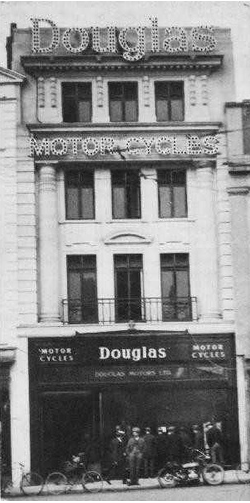 |
| Bristol showroom |
During the First World War, Douglas Motorcycles of Hanham Road,
Kingswood, won an army contract and produced 25,000 machines for the
use of dispatch riders in the worst terrain of the Front.
In
1920, William Wilson Douglas, son of the founder of the famous
motorcycle firm took over the company. He had taken part in the 1911
Isle of Man T.T. Races and after the Great War was in the U.S.A and
Canada promoting the firm. In 1923, at the age of 43, William
Douglas tragically died and his family moved away from the area.
In the 1950’s, Ashlands at Warmley the former home of the
Douglas family, was divided up into a number of self-contained
flats. Since the new owner moved here in 1985, a great deal of work
has taken place. A massive boundary wall has been erected and the
stables block has made way for a twelve car garage. In the former
paddock, a lake has been dug and a helicopter pad installed.
For almost three years, the Dirt Track Douglas was the supreme dirt
track machine selling around 1200 in 1929 alone. In the 1920s
Douglas built the first disc brakes, and had a Royal Warrant for the
supply of motorcycles to the Princes, Albert and Henry.
Motorcycle production continued into WWII and was extended to
generators. In 1948, not long after the war, Douglas was in
difficulty again and reduced its output to the 350 cc flat twin
models. The 1955 350 cc Douglas Dragonfly was the last model
produced. Westinghouse Brake and Signal bought Douglas out and
production of Douglas Motorcycles ended in 1957. Douglas continued
to import Vespa scooters into the UK and later imported and
assembled Gilera motorcycles.
The Westinghouse take-over did
not lead to the hoped-for infusion of capital. In fact, there was no
money to retool for the new 152L2 model so this, and the subsequent
Sportique, were merely assembled at Kingswood with local content
being limited to details.
However, there are some things to
be said on behalf of Douglas. Firstly places such as Australia may
be “immense” in the physical sense but they are sparsely populated
compared to Europe with consequent limitations on sales potential.
Furthermore, a scooter is not necessarily the ideal vehicle for
covering large distances in these countries.
Also the
specification of the machines built by Douglas – at least until 1955
– was years behind those built by Piaggio or any of its other
licencees. This put them at quite a disadvantage since the Lambretta
importers in the U.K. were always able to bring in the latest models
from Italy. At the end of the day you can’t blame Douglas for using
every trick to keep their factories busy. After all they were making
scooters in this country-not just importing them- and there were a
lot of people in Kingswood depending on Douglas for employment.
Significantly, all the money being directed towards
manufacturing meant that there wasn’t much left over for marketing.
When you add in the fact that the British-built Vespas were usually
several years out of date anyway then it’s not surprising that
Lambretta got a toehold in this country that they generally failed
to achieve elsewhere.
It seems that Piaggio came to accept
the realities of the situation – i.e. that the British market had
been irretrievably compromised by their decision to go with Douglas
rather than export directly to the UK and good relations became the
order of the day until the demise of Douglas in 1982.
The company also made several other products including airplane
engines, tractors, Vespa scooters, trucks and cars. In 1935 they
were in financial trouble and were taken over by BAC. They continued
to make motorcycles, and in WW2 made generators and bikes. In 1948,
Douglas was again in economic distress and forced to rationalize its
line to a series based on a 350cc flat twin.
The last model
made was the advanced and novel 350cc Dragonfly, in 1955.
Distinctive looks and good handling couldn't hide the low top speed
(75 mph, although a sports model claimed 84mph) and poor low-rev
performance. A 500cc prototype was shown in 1951, but never made.
The company was purchased by Westinghouse Brake & Signal, but new
owners were more interested in making Vespa scooters, and motorcycle
production ceased in 1957, although they continued to import and
assemble Vespas and later Gilera motorcycles.
By the thirties, the motorcycle golden days were over. Douglas tried
designing a car but, for some reason, only six were ever made and
the idea was dropped. In 1936, production of motorcycles was stopped
and the company turned to make the Sprite Mark II, various trucks
and even aero-engines.
The Second World War saw the company
turning out parts for fighter planes and portable generators. Then,
in 1946, the Douglas motorcycle reappeared, together with a new
range of electric vans. In 1949, the company imported its first
Italian Vespa scooter which it began to make under licence.
They applied for and were granted a number of patents. John Douglas,
residing at Woodstock, Kingswood, was co-applicant with the factory
on patents. Where did he fit in?
The Douglas factory ceased production in 1957.
Prince Albert owned and rode a 1922 Douglas Motorcycle.
May 2008:
Developers want to build hundreds of homes on the
former Douglas motorcycle factory site in Kingswood. The 12-acre
plot, which once housed the biggest motorcycle factory in the world,
would be bulldozed to make way for between 300 and 350 homes, some
of which will be affordable homes for first-time buyers. Production
of the famous Douglas motorcycles in Kingswood ended in 1957 and the
buildings where 3,000 people once worked are now used by a number of
small businesses.
Douglas Homes (South West) Ltd is preparing
to submit a planning application as early as September to South
Gloucestershire Council. Tony Doyle, spokesman for developers LPC (Trull),
said Douglas House, which is locally but not nationally listed,
would be retained as part of the massive housing development. The
land has already been earmarked for housing by the local authority
in its Local Plan so it is only the detail and design of the homes
within the planning application that is likely to cause any
controversy. The council has already agreed that the land could
stand a building capacity of about 75 homes per hectare (2.4 acres).
Douglas House, once used for offices, would be restored as part
of the housing scheme.
A Douglas 600cc Dirt-Track Racing Motorcycle c.1929 sold at auction
in 2008 for £6300.
- In 1882, William Douglas and his brother
Edward Douglas
founded the Douglas Engineering Company, first as a blacksmith's
shop, but soon expanded to become an iron founders making
quality castings, and later supplied parts to Joseph Barter, of
Light Motors, for his Fairy engine. After the turn of the
century and the advent of the motor vehicle they soon became
involved in the development of engines.
- 1885 Company founded - presumably William Douglas (Bristol)
Ltd.
- 1907 The first model was introduced at the Stanley Show.
Mounted high in the frame, it had a 2.75hp flat-twin engine with
braced forks and direct-belt drive. They also exhibited a
compact V4 engine, but only two or three of these were made as
the design was too advanced for the times.
- 1909-1912 New frame design brought changes. A two-speed
gearbox became available and a ladies' model was produced.
Douglas began supplying Williamson with 8hp flat-twin engines
for their machines. They also had their first success at the TT,
with a win in the Junior class.
- 1913-1917 For a list of the models and prices of cars see
the 1917 Red Book
- 1913-1917 For a list of the models and prices of motorcycles
see the 1917 Red Book
World War I. Several models were used
by the forces and approximately 25,000 of these reliable
machines went for service use. After the end of the war surplus
bikes flooded the civilian market until around 1920.
- 1920 The W20 model, with its 2 cylinder, 348cc sv engine,
was equipped with clutch, kick starter and three-speed gear. It
has a quite a few accessories, such as handlebar mounted watch,
speedometer, full Lucas acetylene lighting, leather knee pads,
protective shield under crankcase, holder for spare spark plugs
and round leather case for spare tube or belt.
- 1920s During the decade, Douglas had a Royal Warrant for
supplying motorcycles to Prince Albert (late King George VI) and
Prince Henry. Even King George V acquired a Douglas machine in
this period.
- 1921 The 3.5hp model was dropped and pivot-forked rear
suspension made a brief appearance. This was followed by the
introduction of two models with ohv engines.
- 1923-1925 The firm did well in the TT and proved that their
motorcycles were good performers in many classes. During this
period Cyril Pullin became Chief Designer for Douglas.
- 1926 An 'all-new model' was launched as the EW - designed to
appeal to those who demanded performance without a high price
tag.
- 1927 By now there were five versions of the EW, and although
a serious fire damaged the works, Douglas saw success in
Australian dirt-track racing as the low-slung design was well
suited to the terrain.
- 1928 Cyril Pullin left the firm, to be replaced by Freddie
Dixon, who produced a racing TT model. It was later joined by a
dirt-track model designed specifically for speedway.
- 1931 The firm had become a public company and was sold by
the family.
- 1932 New models were added, but the firm was soon in
financial difficulty.
- 1932 The light air-cooled engine had been adapted for use in
light aircraft by British Aircraft Co.
- 1934 They produced a 494cc shaft-drive model called the
Endeavour. William Douglas, by now quite elderly, bought back
the faltering business and produced a smaller range until the
end of the decade.
- 1935 Herr Kronfeld made a record flight from Croydon to
Paris in an aircraft powered by a Douglas engine[1].
- 1935 The company was in financial trouble and was
voluntarily liquidated. The factory was purchased by the British
Pacific Trust[2]. It had been used for making motorcycles and
light aero engines. The new owners would use it for making aero
engines and accessories. A new public company Aero Engines Ltd
was launched which planned to halt production of motorcycles,
concentrating instead on engines for aircraft.
WWII During
the war, Aero Engines made a range of products, more than half
of which carried the Douglas name.
- 1946 Aero Engines changed its name to Douglas (Kingswood)
Ltd[3]. Issue of shares to raise capital.
- 1947-1950 Douglas launched various new models.
- 1948, Douglas was again in economic distress and forced to
rationalize its line to a series based on a 350cc flat twin.
- 1951 A 500cc prototype was shown but never made. An
agreement was made for the company to build the Italian Vespa
scooter under licence.
- 1955 The last model made was the advanced and novel 350cc
Dragonfly. Distinctive looks and good handling could not hide
the low top speed (75mph, although a sports model claimed 84mph)
and poor low-rev performance.
- 1956 The firm was taken over by Westinghouse Brake and
Signal Co.
- 1957 The Vespa was still imported, but the end of the
Douglas model was close.
- 1961 Light engineers and metal founders, specialising in the
manufacture of Vespa Motor Scooters, Road Brakes and Signal and
Colliery Equipment. 2,000 employees.
- Note: For many years afterwards, still trading under the
Douglas name, the company imported Gilera mopeds and lightweight
motorcycles.
The Family
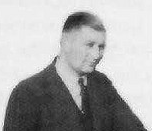 |
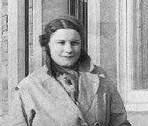 |
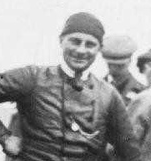 |
 |
Jack Douglas,
Grandson of the founder
1934 |
Rosina Douglas,
a daughter, 1935 |
Willie Douglas,
1922 |
William Douglas |
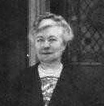 |
 |
 |
 |
| William's wife, Elizabeth |
Bill Douglas, 2007 |
The Douglas brothers |
Douglas Motorcycles
advertisement |
 |
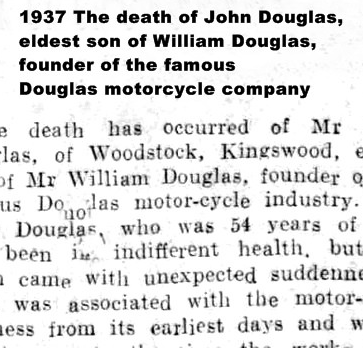 |
 |
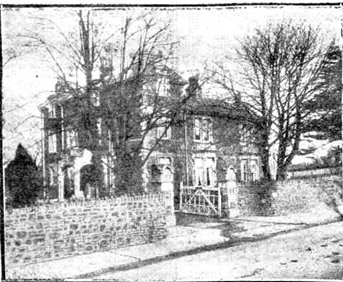 |
| Mary Ethel Douglas |
John Douglas
death notice, 1937 |
Sale notice, Ashlands
contents |
Sale notice, Ashlands
house |
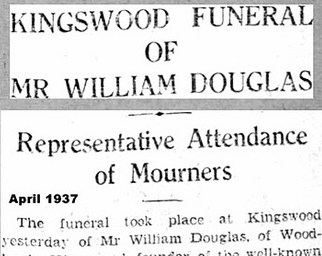 |
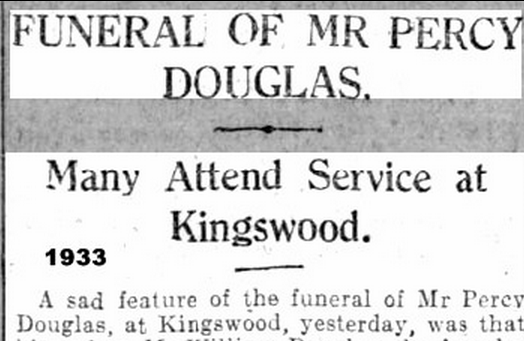 |
|
|
William's funeral
mourners |
Percy's funeral
mourners |
|
|
Little is known about the early life of the Douglas brothers,
William and Edward, apart from the fact that the family lived in
Greenock and 'were of the Douglas Hamilton clan', which accounts for
the Scotsman badge and the tartan tank bordering used on some of
their motor cycles manufactured during later years. William
originally came to Kingswood on the eastern outskirts of Bristol, to
repair bootmaking machinery, had started the company, as an
engineering concern, in 1882.
Ethel Douglas was born in Melbourne Australia and was the niece
of William Douglas and daughter of his brother John Percy
Douglas (1862-1930) who emigrated to Australia from Bristol
around 1880.
After John Douglas's wife, Jeannie, died in
1897 he sent his older children (thought to be Vera, Roderick,
Arthur, and Alan) back to Bristol to live with his brothers who
ran what would become Douglas Motorcycles.
Mary Ethel
Douglas married William Bertie Cox on 13th April 1913 and the
reception was at "The Woodlands", (2) the home of William &
Elizabeth Douglas in Court Rd, Kingswood. The house was located
close to the junction with Hanham Rd and is now the car park for
a care home and parish rooms.
William, brother to Edward, had a son, William Wilson Douglas.
William Wilson Douglas had two nephews, Jim and Jack. There were
also two girls, who may have been daughters or nieces, Rosie/Rosina
and Renee/Irene. A Douglas daughter (of whom?) reportedly married a
Williamson, of Rex Bikes, and another reportedly married Willy Messerschmidt (1).
William and Edward were cousins (by marriage, maybe?) to William
Williamson, of Rex Bikes, who. after 1911, founded the Williamson
Motor Company (which used Douglas engines in its cars). William
Williamson had a brother, Harold.
An early Messerschmidt airplane used a Douglas motorcycle engine.
Segelflugzeugbau Harth-Messerschmitt Designs - 1922-25
S 15 -
1923 motor glider, 1 x 10 hp Victoria (repl. by 14 hp Douglas)
--
considered a powered development of the S 14, wheels repl. skids
S 16 - Bubi, 1924 2-seat (tandem) light aircraft, 1 x 24 hp Douglas
Sprite
- S 16b: second a/c. Sim. to S 15 but with higher pedestal
for wing
-- first design entirely by Messerschmitt, Harth leaves
firm in 1923
The Douglas engine taken from the S 16b. Took part in the
Zugspitzflug in Jan. 1925 (Competion number 3)
Messerschmitt
Flugzeugbau - Messerschmitt Flugzeugbau GmbH - 1925-27
M 17 -
Ello, 1925 2-seat (tandem) light aircraft, 1 x 32 hp Bristol Cherub
III
-- reduced-scale S 16, options: 24 hp Douglas Sprite or ABC
Scorpion, 8 built
 |
|
Geoff Brazendale and his 100 year-old Douglas motorcycle with
the Duke of Buccleuch at Drumlanrig, July 2014 |
| |
|
|
| |
|
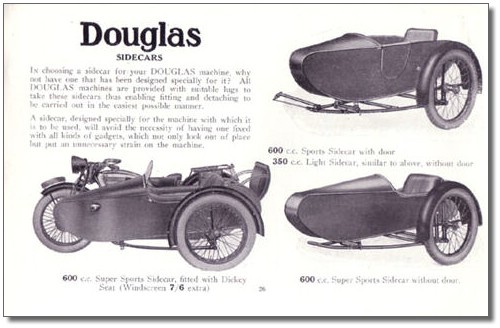 |
| |
|
|
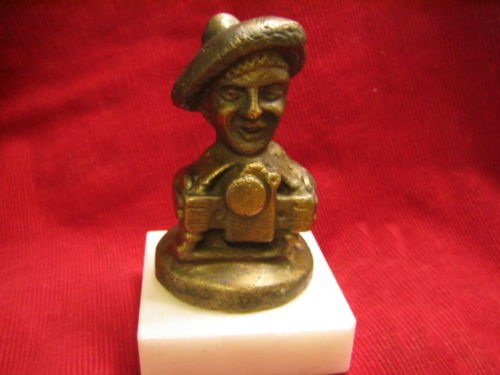 |
|
Cast
bronze replica of the famous Douglas mascot called "Wee Jamie",
depicting the Douglas Scotsman holding an engine 1919/20. |
|
Pin badge |
|
 |
Notes:
1. I have been searching for
evidence of this marriage, but it appears Willy Messerschmidt met in
the 1920s 'Lilly Stromeyer, nee Baroness von Michel Raulino and
daughter of the financier Michel Raulino know from Bamberg tobacco
dynasty, which was widely known as "The Baroness". They even helped
him several times later, with millions of dollars in guarantees from
financial emergencies. After the Second World War, they legalized
their relationship and married.'
2.
Photograph of the wedding group
3. In 1864 a William Douglas was living in Bell Hill, St George and
was described as an engineer. He took out a mortgage on a property
in Two Mile Hill occupied by John Douglas.
4. I am grateful to Paul Townsend whose research has contributed to
the family history.
See also:
•
Notes on the Douglas family and the Kingswood motor cycle factory.
(1.23mb pdf)
Bill Douglas, the founder's
grandsonBristol businesses
The Douglas milk float
Douglas airport tug
Douglas car
Any contributions will be
gratefully accepted
Errors and Omissions
|
|
The Forum
|
|
What's new?
|
|
We are looking for your help to improve the accuracy of The Douglas
Archives.
If you spot errors, or omissions, then
please do let us know
Contributions
Many articles are stubs which would benefit from re-writing.
Can you help?
Copyright
You are not authorized to add this page or any images from this page
to Ancestry.com (or its subsidiaries) or other fee-paying sites
without our express permission and then, if given, only by including
our copyright and a URL link to the web site.
|
|
If you have met a brick wall
with your research, then posting a notice in the Douglas Archives
Forum may be the answer. Or, it may help you find the answer!
You may also be able to help others answer their queries.
Visit the
Douglas Archives Forum.
2 Minute Survey
To provide feedback on the website, please take a couple of
minutes to complete our
survey.
|
|
We try to keep everyone up to date with new entries, via our
What's New section on the
home page.
We also use
the Community
Network to keep researchers abreast of developments in the
Douglas Archives.
Help with costs
Maintaining the three sections of the site has its costs. Any
contribution the defray them is very welcome
Donate
Newsletter
If you would like to receive a very occasional newsletter -
Sign up!
|
|
|
|
|
|
|
|


